A couple of months ago, I was delayed between flights returning from a work trip to the Central Coast of California. 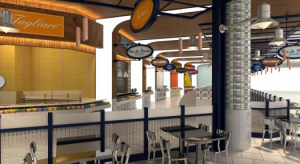 As I sat eating a soggy quesadilla and sipping unenthusiastically on a watered-down margarita—truly, the best meal I was going to find within 20 yards of my gate–feeling awfully sorry for myself in the purgatory of modern-day air travel, I couldn’t help but wonder: Does airport food always have to add insult to injury?
As I sat eating a soggy quesadilla and sipping unenthusiastically on a watered-down margarita—truly, the best meal I was going to find within 20 yards of my gate–feeling awfully sorry for myself in the purgatory of modern-day air travel, I couldn’t help but wonder: Does airport food always have to add insult to injury?
Fly the Food-Friendly Skies
Well, as it turns out, no. It doesn’t. There’s been a pervasive movement–albeit maybe a little slow in coming for some of us who spend a lot of time in airports—toward upping the ante of food quality in the land of fly by day and night.
Millions upon millions of travelers fly every year in the United States alone. Some of them amble onto a plane for an annual holiday trip to see the family; some fly nearly every day. All have been subjected to the greasy, fast-food fandango that is inevitably the only game in town (or, at least, near your gate). But no more. Or, at least, much less so.
While waiting for my flight home from Washington State a few weeks ago I was treated to awesome fish tacos in the Seattle Airport at Anthony’s, a local seafood chain that focuses on nabbing fine finned creatures from Northwest waters, not to mention some great Washington wine at Vino Volo.
And it seems, while we’ve still got a ways to go (hello, LAX and EWR!), there’s some seriously high-quality hash being slung at a terminal near you. And thank goodness, because according to the FAA, about 75% of all national flights land on time, but that leaves a quarter of them, and thousands of cranky, hungry, thirsty, weary passengers, delayed in American airports around the country every day. Of course, one man’s agony is another man’s triumph.
“We looove delays, and lightning and thunder…” laughed Dave Allan, a spokesperson for OTG Management, the company behind many successful airport eatery revamps over the last 14 years, and also my lunch date for a tour around the recently redone food court in La Guardia’s Delta Terminal.
I’d read a quick bit from the New York Times’ Flo Fab about the August overhaul of Terminal D, and I was nothing less than intrigued at the New York names who’d signed on for the project: The amazing chef Michael Lomonaco of Porterhouse in the Time Warner building; meat from carni-god Pat LaFrieda; a French bistro (!) care of Minetta Tavern’s Lee Hanson and Riad Nasr; and then the kicker that really got my stomach grumbling: Pizza from the King of Avenue J, Di Fara. Be still my hungry heart. Not only that, but this was just the initial roll-out. Over the next year, there are plans for a seafood spot compliments of chef Andrew Carmellini, another pizza joint from Co.’s founder Jim Lahey, and a little trattoria from ‘ino’s Jason Denton. Reading all this, I felt like I was dreaming after a pre-plane-boarding Xanex; could it be true? I skipped breakfast, held my breath, and set out to uncover the edible (or inedible) truth.
For a Reservation, Kindly Remove Your Shoes
Allan met me at the Delta Terminal in La Guardia at 11 am on a sunny morning and ushered me through the usual security rigmarole. But as lovely a day as it was to fly, I wasn’t there to get on a plane—I was there to eat. As we did a quick walk through, I complimented him on the company’s ability to get such great local talent on board which, as it turns out, is kind of OTG’s ace in the hole. “When we’ve signed on for a project, our executive chef will go live in that market for a few weeks to get to know what the food scene is like, and then we’ll go about bringing on board local talent for the project,” he says.
“At first, it was a little tough—after all, what chef wants to be associated with airport swill? But with the success of their Cibo Express spots, whose organic, on-the-go offerings can be found in airports in Orlando, Philadelphia, Tucson, Boston and Chicago, not to mention the full-on gustatory success of JFK’s Terminal 5, many city-centric chefs are beginning to see that signing on for a piece of the airport pie is a way to extend their reach to new, ravenous diners. “Travelers want to taste the city they land in,” said Allan. “Some people just land in that airport and are changing planes; they never get to see the city. This way, at least they get to taste it a little. Are chefs calling them now to sign on? “Well, not yet. But they are taking our calls now.”
Many city-centric chefs are beginning to see that signing on for a piece of the airport pie is a way to extend their reach to new, ravenous diners.
I quickly was to understand why. A smiling hostess seated us at a sleek wood-veneer table decorated with a vase holding a fresh, pink dahlia at Prime Tavern, Michael Lomonaco’s meat-centric stop. As I perused the menu, chock full of tempting offerings like an heirloom tomato salad, 14 oz. dry-aged New York Strip steak, a lobster roll, and lamb porterhouse, a cheerful (but not too cheerful) black-clad waiter brought us water with slices of lemon. I settled on the Hudson Valley smoked salmon on crostini with dill yogurt and a grilled skirt steak sandwich with chimichurri sauce and caramelized onions. The salmon was velvety and super fresh, and the steak sandwich was, wow, tender, juicy, cooked the way I asked (medium rare), and topped with a vibrant green just-vinegary-enough chimichurri sauce and thinly, thinly sliced, perfectly caramelized onions on a fluffy, crusty outside, soft inside freshly baked roll.
It killed me not to eat it all because, damn, I actually forgot I was in an airport for 15 minutes, but Allan had ordered me two slices of Tagliare pizza and a burger from Pat La Frieda Burger. The verdict: The slices—one grandma style square, one triangle with pepperoni—from the Di Fara outpost was not as good as Di Fara, but they were a far and delicious cry from the usual cruddy, congealed nonsense that’s standard airport fare; decent crust and an unexpected bonus: fresh basil!); and as for the LaFrieda burger, it was a luscious, medium-rare patty that was not formed by a machine, but by someone’s hands, and topped with a bright (read: not anemic), delicious tomato and a thick slice of melted American cheese—good, crispy fries, too!
Bistro By the Gate
Our next stop was Bisoux, a casual French-style bistro with soft, low lighting, cool, red wall prints that, upon closer inspection, you realize are the metal girdings of the Eiffel Tower, and where you can eat a lovely roasted beet salad with watercress, endive, pear, walnuts, blue cheese, order up a pleasantly gooey croque monsieur, or (as I did) gamble on the country paté. At the table next to me sat three women who’d ordered a fab looking trio of cocktails (which, for all the restaurants, were created by the talented mixologist Tad Carducci; beer menus are courtesy of Brooklyn Breweries Garret Oliver; and wine lists from Chris Cannon, the genius behind Alto’s much lauded list, among others), and for half a second I thought I was actually in a normal restaurant. When my plate arrived, my jaw dropped:
The gorgeous pork terrine dotted with bits of green olive came with a lovely little stack of cornichons, great grainy country mustard, and golden toasted pieces of brioche that made me feel more like I was in Lyon rather than Queens. After that, came the crème brulée.
As I cracked the sugary, perfectly browned, caramelized surface and plunged my spoon into its plush, eggy custard, I realized that two hours had passed, and I hadn’t even noticed. 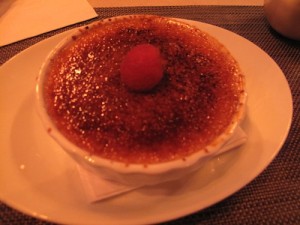 The waitress wrapped up the paté to go for me (another bonus: you can take that, and an unfinished bottle of wine, onto the plane with you– sweet!), and I asked Allan if OTG had plans for more like this. As it turns out, yes: 90 percent of all airport food contracts will be up in the next decade, and with operations like OTG upping the ante on quality and bidding for the projects, we may not be thrilled about plane delays, but we might start to mind them a little less.
The waitress wrapped up the paté to go for me (another bonus: you can take that, and an unfinished bottle of wine, onto the plane with you– sweet!), and I asked Allan if OTG had plans for more like this. As it turns out, yes: 90 percent of all airport food contracts will be up in the next decade, and with operations like OTG upping the ante on quality and bidding for the projects, we may not be thrilled about plane delays, but we might start to mind them a little less.
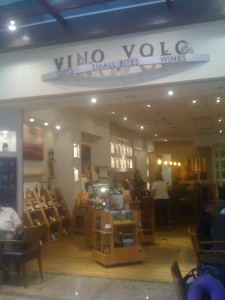
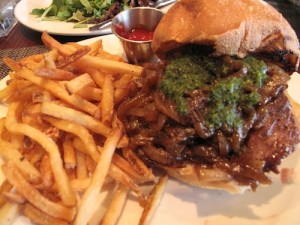
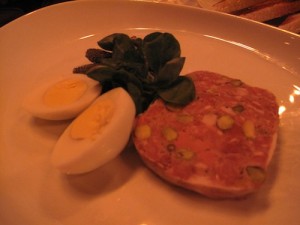
RT @ToqueMag: Airport Food Looking Up http://bit.ly/chaAAN